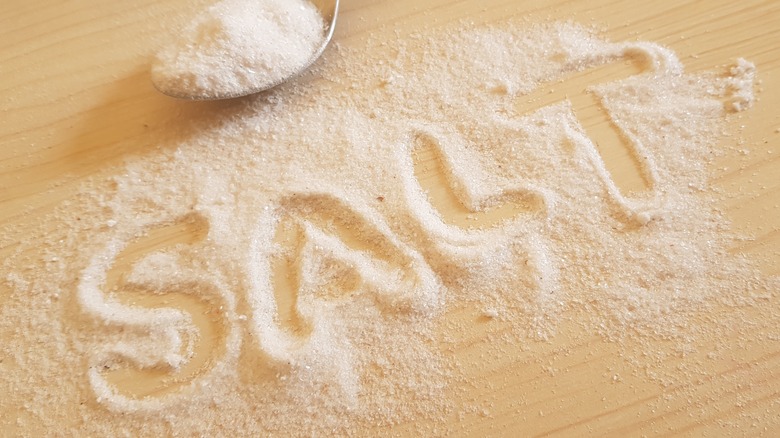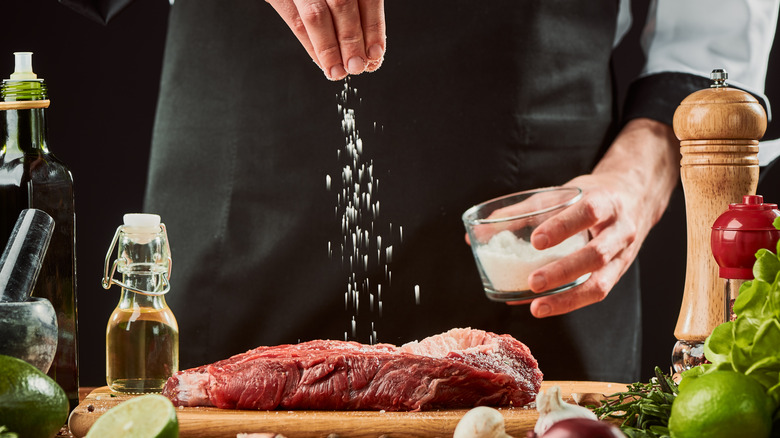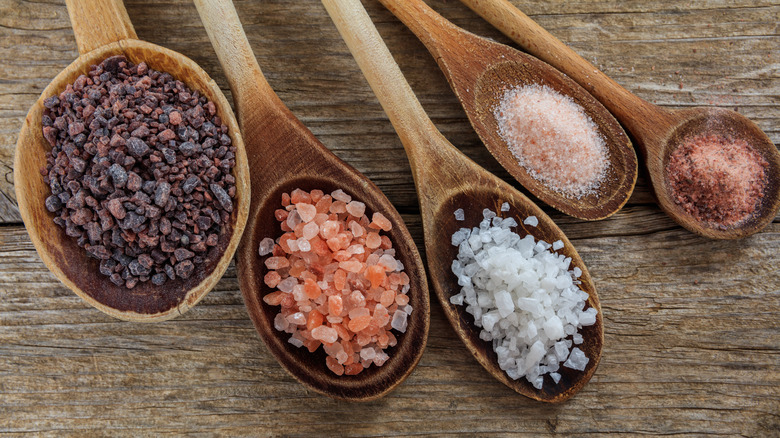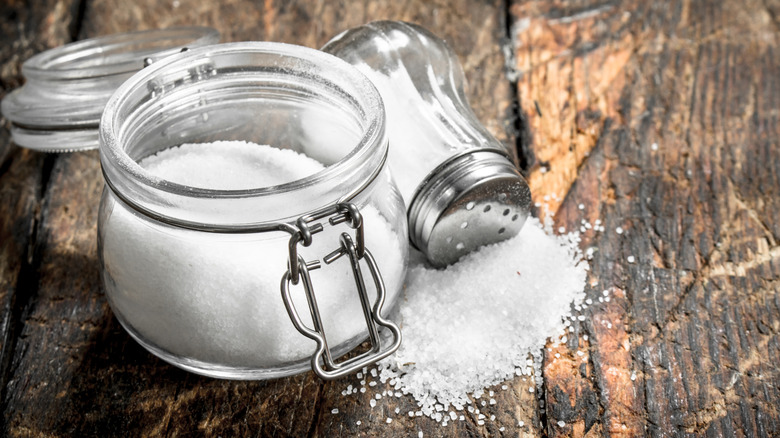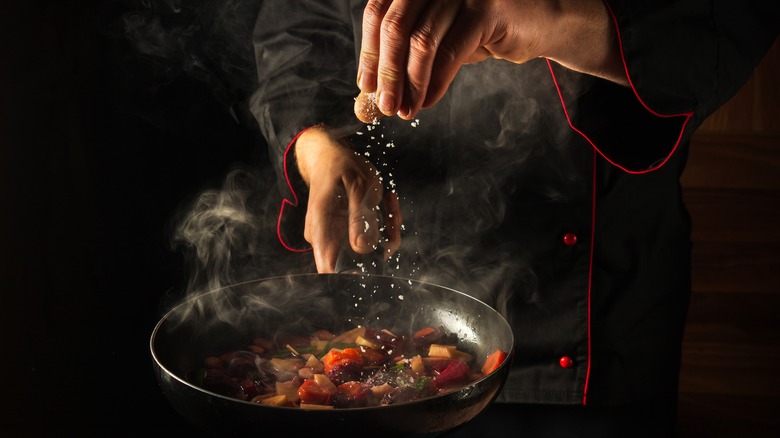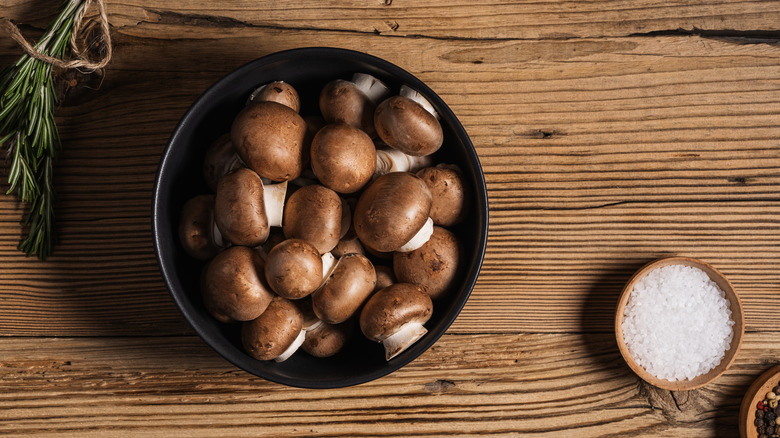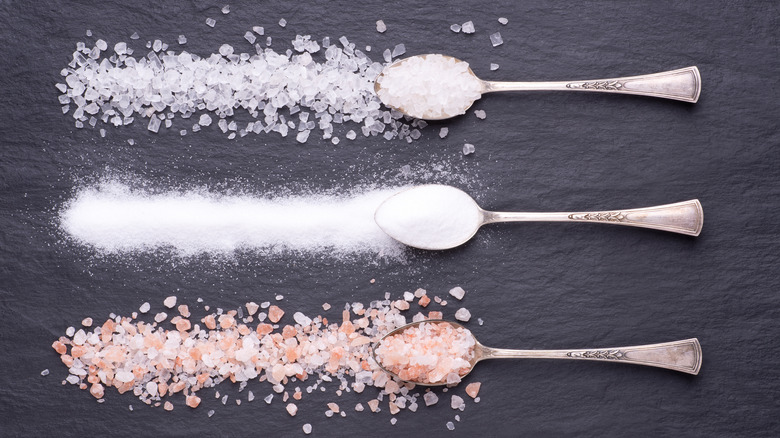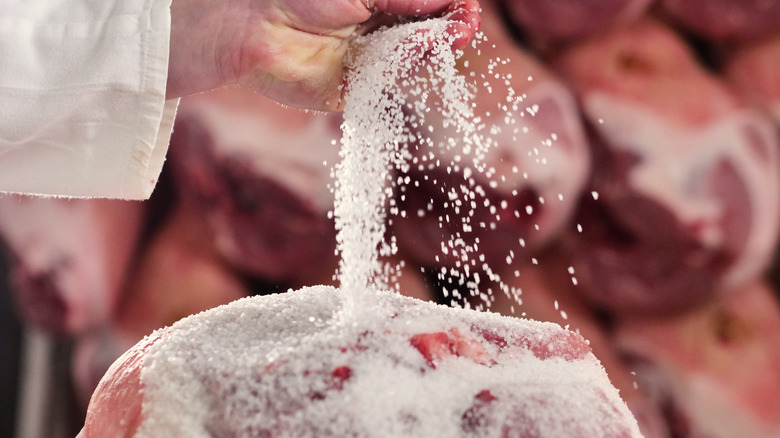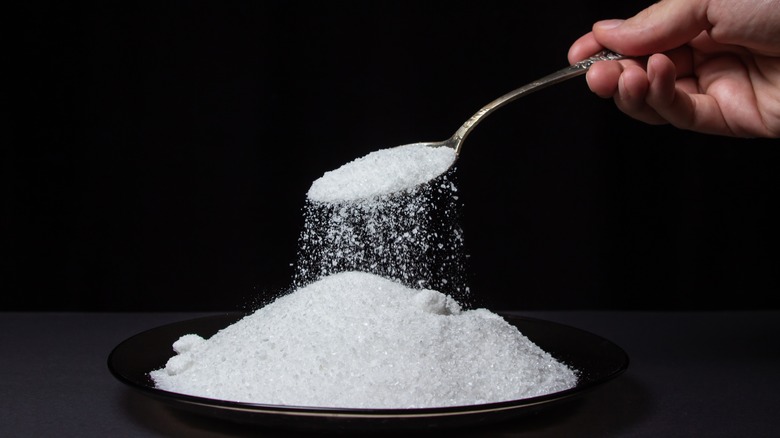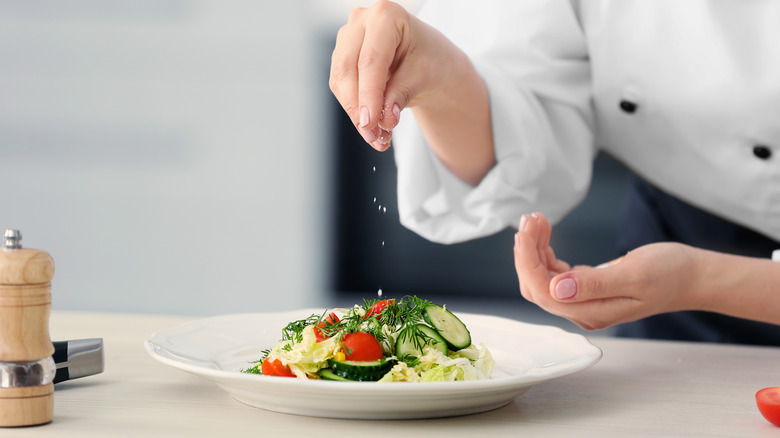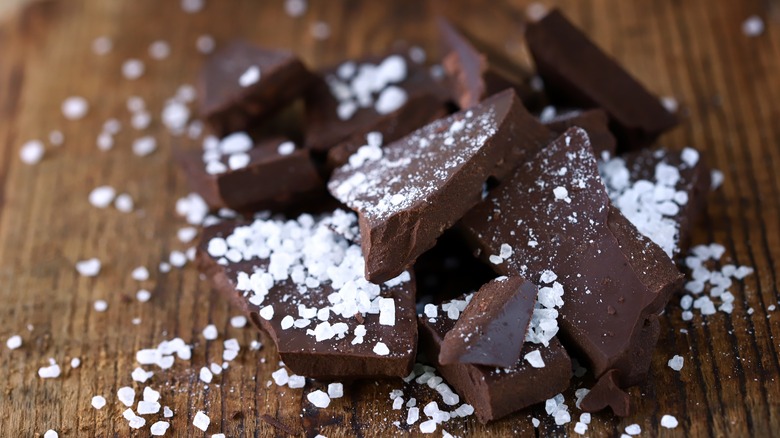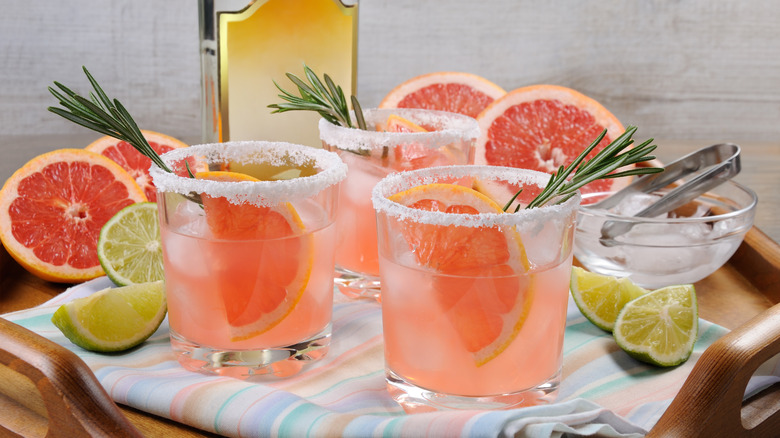12 Salt Mistakes You May Not Realize You're Making
As humans, we don't just crave salt for the taste — we need it to survive. The compound known as sodium chloride is essential for our bodies as it is crucial to the operations of our cardiovascular and nervous systems, per The New York Times. Thanks to its critical health importance, and its usage as a food preservative, salt has been a coveted commodity by civilizations all over the world since ancient times, traded as a treasured ingredient, and even used as currency (per Time). Today salt is widely produced and readily available, with a rainbow of varieties gracing store shelves and gourmet cook's pantries. Everyone cooks with salt. But do you really know how to use it?
Maximizing the positive effects of salt in cooking is one of the most essential skills a cook can develop. Learning when, why, and how to add salt to your dishes will boost the flavors of your food perhaps more than any other technique. And to do that, it's helpful to know what errors cooks commonly commit in the kitchen that can lead to an over- or under-salted dish. Avoid that disappointment by keeping these salty mistakes in mind, and your food will thank you for it.
1. You don't understand how salt affects food
Salt affects our perception of flavor in so many ways that it almost seems mystical. Luckily, science can explain these reactions, and once we understand them, we can better utilize the ingredient in our cooking. As the The Guardian explains, salt changes not just the flavor of food, but its aroma and texture as well.
When salt is combined with something bitter, the sodium ions alter how our taste buds perceive that sensation, smoothing out the sharp bitter edges and mellowing it out. If that food or drink also has a sweet taste, once the bitterness is tamped down, the sweetness will intensify. When it comes to aromas, salt enhances them by pulling liquid to the surface, and the aromatic compounds that come with it.
Salt's ability to draw water out of food can drastically change that food's texture. For instance, some ingredients become tough while others become mushy when prepped or cooked with salt. It's important to understand each food's individual reaction to know when and how to effectively season it. As Chef Danielle Alvarez explains (per Good Food), salt also dismantles proteins to help soften tough meat, and it has anti-bacterial properties to keep food from spoiling. It's an all-around game-changer when it comes to cooking, and the better you understand how it works, the better your food will taste.
2. You're not using different types of salt for specific purposes
Have you ever gaped at the endless varieties of salt and wondered what they could possibly all be for? Believe it or not, every type of salt brings something different to the table. If you're only using one style in your cooking, you're not taking full advantage of the range of enhancements that salts can bring to your food.
While table salt is the style most commonly found in shakers, it's also the least flavorful and most processed variety. Most cooks opt for kosher salt, according to Master Class, as it's adaptable to many uses. It also has better flavor and texture than plain table salt, as Salt Works points out. Then there's sea salt, a catch-all term that encompasses many types that are harvested from bodies of saltwater -– specialty salts like Hawaiian salts and Sel Gris from France fall under this category. They have a wide variety of uses, like kosher salt, and lots of flavor. Additionally, mineral salts make up another category. Mined from salt deposits, these include unique styles like the mild rose-pink Himalayan salt and the intensely flavored Kala Namak, also known as black salt.
Just as important as the salt's origin is its texture when determining its best usage. A finer grain will dissolve more easily in food, while a coarser crystal can add texture. The large, wide crystals on flake salt make it ideal as a final touch, sprinkled atop a finished dish.
3. You're not storing salt correctly or keeping it close at hand
Salt by itself is a preservative, so as you might presume, it doesn't go bad like other foods. However, as Morton Salt discusses, it may not stay at maximum intensity indefinitely. Depending on the style of salt and whether or not it includes additives, salt, like any spice on your shelf, has a limited window of peak potency. Two to five years is a good guideline to keep in mind, although a pure salt with no additives (such as iodine, flavorings, or anti-caking agents), when stored properly, can theoretically last forever, per Reader's Digest.
Remember that salt draws moisture from the environment around it, which is great for certain cooking purposes, but a challenge for storage. Keep it dry or it may pull in too much, resulting in crystals that are clumped together. Salt will also pull in aromas from the air in addition to moisture, so it's best to keep it stored in an airtight container to keep it from taking on unwanted smells and flavors.
But salt that's sealed up in a cool, dry pantry is inconvenient to frequently access. If you cook a lot, it's a good idea to keep some handy, always at arm's reach. A salt pig, interchangeably known as a salt box or salt cellar, as Saveur explains, is a great kitchen item for a regular home cook. Keep one full on your countertop and you'll never forget to season your food.
4. You don't salt certain foods ahead of time
Timing is everything, as the saying goes, and this concept is key to understanding how to properly season with salt. While some foods don't need or want salt treatment early in the preparation process, others will improve in flavor, texture, or both if salt is promptly applied and left over time to do its work, as Popular Science explains. Unfortunately there are no hard-and-fast rules to follow, but there are a few examples that can illustrate when early salting works and when it might not.
Generously salting or dry-brining whole pieces of meat hours or even days ahead of cooking is generally a good idea (per Good Food). This time allows the back-and-forth process of osmosis to occur. In other words, salt pulls moisture out, the moisture dissolves the salt, and then it sinks back into the surface, penetrating the meat so you end up with even seasoning all the way through. Moisture-heavy vegetables such as eggplant benefit from early salt treatment, as it pulls out excess water that could turn them soggy during cooking. More so, many other vegetables can benefit from salting or brining in advance, as Wired discusses, from carrots to cauliflower. And if you're boiling vegetables, make sure the water in your pot is heavily salted, like seawater, to help the salt penetrate their interior for more even flavor.
5. You're not salting little by little or tasting as you cook
The ever-present danger of over-salting hangs like a specter over many cooks. Too much salt can make a dish at best unpleasant, and at worst inedible. One of the best ways to avoid this dreaded outcome is to learn to season with salt little by little, throughout the cooking process, and to taste as you go, as Chef Works explains. While there are ways to fix a too-salty dish, it's easier to err on the side of caution and add salt a bit at a time to avoid such a scenario.
Unless you're baking, which requires more precision, it's best to take any salt measurements in a recipe with, well, a grain of salt. Salts measure differently depending on their texture and type, and the other ingredients you're using may not match up exactly to those used by the recipe testers. It's best to use the given amount as a guideline, making sure to season each element of the dish conservatively as you cook, and continuously taste your food, adjusting the salt level pinch by pinch until it tastes well-seasoned to your palate.
6. You're adding salt too soon to certain foods
While many meats and vegetables benefit from early salt treatment, there are others to be aware of that won't fare so well when subjected to a long seasoning process. Unlike poultry, pork, and beef, fish and seafood in general don't need to be salted too far in advance of cooking -– Good Food recommends up to 15 minutes. Any longer than that, and the proteins can toughen up, leading to an unpleasant texture.
If you're cooking a dish that's largely liquid, like a stock, soup, or stew, you'll want to be extra careful when you add salt, as Popular Science warns. While the liquid cooks, it reduces through evaporation, thus concentrating the flavors. Seasoning that may have tasted perfect at the beginning of cooking may be way too heavy by the end.
Mushrooms are another ingredient to watch out for when it comes to salt. As Jacobsen Salt explains, mushrooms contain so much moisture that salting too early pulls it all out, leaving them limp and watery and unable to brown properly. It's best to wait until late in the cooking process to add your seasoning.
7. You're not measuring each type of salt correctly
Many types of salt may look similar enough to the naked eye, but the actual size and texture of crystals can vary greatly. This has major ramifications when it comes to measuring, as Master Class explains. If you're scooping out teaspoons and tablespoons according to recipe instructions, you may be using too much or too little, depending on the size of your salt crystals.
Table salt tends to be the finest grain, which means there is less empty space between crystals so you'll get more salt in each measurement compared to other types. Sea salt that's categorized as 'fine' will still have a bit more space between crystals than table salt, as it's less processed so the texture is less even. Even among salts of the same variety there can be a big difference in shape and size. The two major brands of kosher salt on the market, Morton and Diamond Crystal, don't measure up the same – it takes 2 teaspoons of Diamond Crystal to equal 1½ teaspoons of Morton.
The best way to accurately measure salt, or any ingredient for that matter, is to use a scale. If your recipe lists ingredients by volume as well as weight, going by weight will give you the most accurate results, especially if the type of salt is not specified.
8. You're not accounting for other salty elements in a dish
Crystals aren't the only way to incorporate salt into your food. A lot of ingredients are salty by nature, and they will contribute seasoning to your dish whether you add pure salt or not. This is another reason why it's imperative to taste your food at different stages of the cooking process as some ingredients may be salty enough that you don't need to add more.
Anything packed in salt or brine is an obvious ingredient to look out for –- things like olives, capers, and anchovies, as Mark Bittman points out on Medium. The saltiness of these items can be moderated, as Kitchen Stories explains, by submerging them in water for a bit. Hard cheeses like parmesan and pecorino can be quite salty, while soy sauce and fish sauce are also intensely saline, so salt should be used moderately in dishes that contain them. Salt is a necessary element in curing, pickling, and fermenting, so anything that's gone through those processes will have a salty taste -– think pickles, miso, kimchi, bacon, and salami. And, of course, make sure you know if any butter you're using is salted or unsalted and adjust accordingly.
Your best bet is to taste the elements of your dish individually before adding them, and then see how much seasoning they contribute to the dish as you incorporate them. With enough naturally salty ingredients, you may not need to add any further salt at all.
9. You don't know how to fix an over-salted dish
No matter how careful you are, at one point or another, everyone is going to over-season a dish. The good news is, there are multiple ways to fix food that's been inundated with too much salt. So if you got a little too enthusiastic with your salt bae impression, don't worry -– all is not lost. A simple adjustment may be enough to save the day.
As Well and Good discusses, adding fat is a great way to offset saltiness. If your dish is mostly liquid, like a soup, simply adding more of any kind of liquid (as long as it's not salty itself) will help to diminish the overly-saline flavor. Acidic elements are also helpful in this regard, as the tartness of citrus juice and vinegar is a good foil for salt on our palates. Another flavor category that helps mitigate saltiness is heat -– if you can handle a decent amount of chili in your food, you can rev up your dish with hot sauce, piquant spices, or whole or chopped peppers to balance out the over-seasoning.
Just make sure that you're tasting and adjusting little by little when making these alterations, just as with adding salt, so you know when you've reached the right balance. Otherwise you could find yourself with an under-seasoned dish and have to start the process all over again.
10. You're not using finishing salt as a final flourish
Your completed dish may be thoroughly seasoned, but if you want to add an extra pop of flavor, texture, and allure, a light sprinkling of finishing salt on top will take it to the next level. A light dusting of tiny shimmering jewels atop your food can make the difference between a good dish and a great, gourmet masterpiece.
Technically, any kind of salt can be used as a finishing salt, but some are more suited to the purpose than others. Texture and flavor are very important when selecting a finishing salt for your dish, as these crystals won't be cooked down with the rest of your food, but largely left as-is. Many types of sea salt work well, according to LoveSeaSalt, including the highly regarded Fleur de Sel from France, which is not as dried out as other salts, lending it a uniquely rich flavor.
Flake salts such as Maldon work wonderfully as finishing salts because of their elegant shape and delicate texture. Flavored salts, such as smoked salt, can add a punch of flavor and aroma that will give your food an extra layer of depth. Just be sure you don't get too exuberant -– you want your finishing salt to act as an accent to the rest of your seasoning, not overwhelm it.
11. You're not adding salt to sweet foods
Salt, in its near infinite versatility, is not just for savory foods like steak, french fries, and popcorn. Its ability to enhance our perception of sweetness makes it a great addition to fruits, cakes, candies, and all kinds of desserts. If you've spent any time in the South, you've probably enjoyed a slice of watermelon dusted with salt, a common treat in the region, as The New York Post describes. Salt boosts the fruit's natural flavor and succulent texture.
Science explains that the combination of sugar, in the form of glucose, together with salt intensifies our taste response. This reaction explains the enduring popularity of foods like salted caramel and chocolate-covered pretzels. As it does with savory food, salt heightens the flavors that are there, and also magnifies our perception of sweetness, making sweet treats and desserts even more delectable. As salt also diminishes bitter flavors in food, it's especially useful as an addition to dark chocolate, which has natural bitterness, as The Cooking Bar explains.
12. You're not using salt in beverages
The same principles that apply to sweet and savory dishes also apply to beverages, too. The endlessly adaptable seasoning shouldn't be limited to gracing the rims of margaritas and micheladas. Salt can add and enhance the flavors of just about any drink, hot or cold, alcoholic or not, whether it's used as a garnish or mixed in as an ingredient.
Salted yogurt drinks, like ayran which hails from Turkey, have been around for ages and can be found all over the world, as The Washington Post explains. Famous food nerd Alton Brown adds salt to his coffee, as its bitterness-dampening ability helps mellow a particularly intense cup of joe, while boosting its flavor (per Homegrounds). And just as a bit of salt enhances fresh fruit, adding a pinch to drinks like lemonade can give them an extra level of taste, as Lifehacker recommends.
The use of salt as a cocktail ingredient has expanded in recent times, as mixologists have discovered its benefits aren't just for food (per Saveur). Its talent for punching up flavors and toning down bitterness makes salt the perfect companion for complex cocktails. Mixologists are creating new ways to utilize salt in their drinks, from the familiar salt rim, original saline solutions, or by crafting their own salt-infused liqueurs. The next time you make a cocktail, don't forget to add a pinch of salt.
